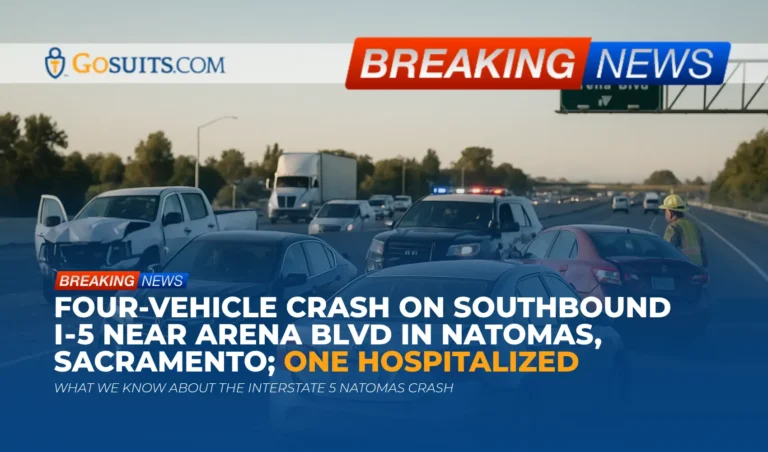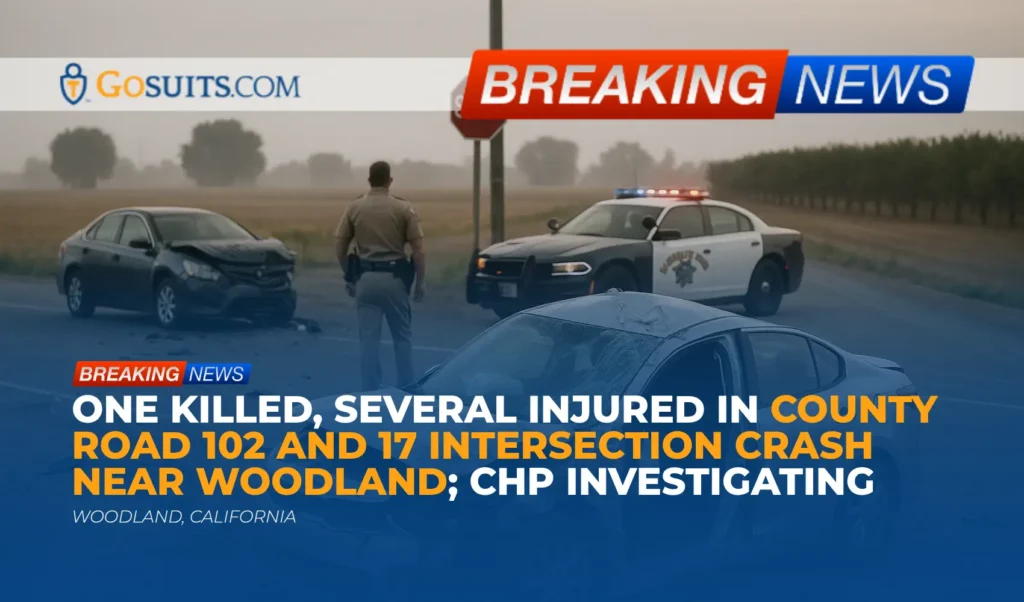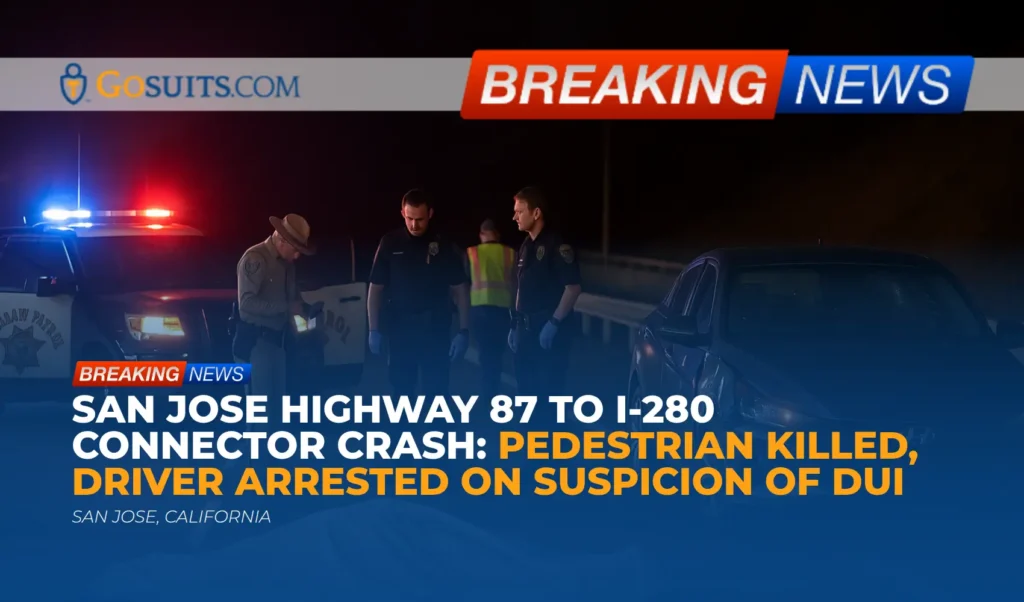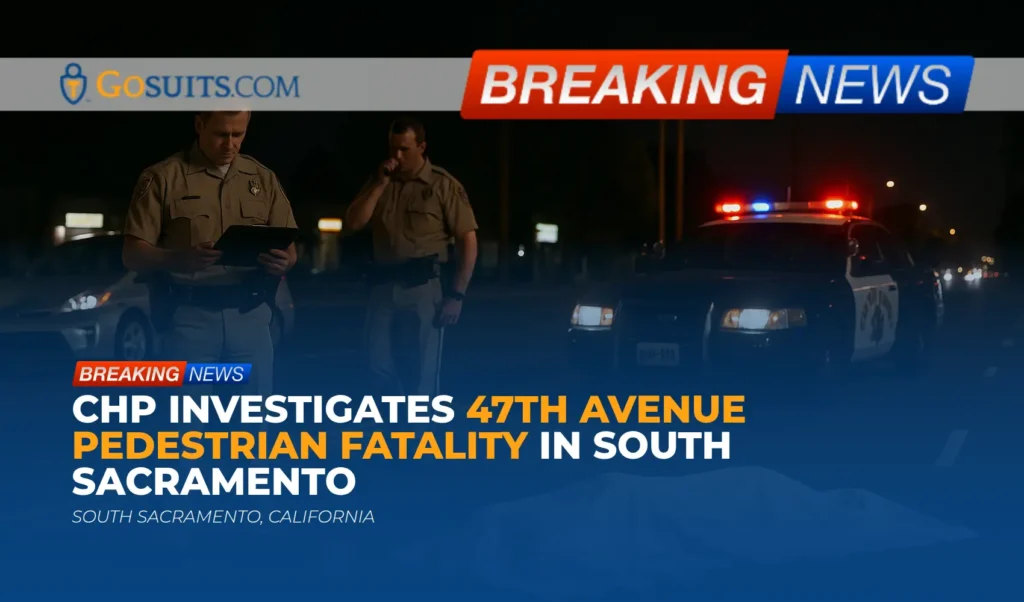- What We Know About the Interstate 5 Natomas Crash
- Location, Time, and Agencies Involved
- Immediate Health and Safety Steps After a Multi‑Vehicle Collision
- How to Get Key Records and Information
- Legal Rights and Time Limits in California Traffic Collisions
- Possible Liability in a Four‑Vehicle Interstate Crash
- Insurance Issues and How to Protect a Claim
- Data and Safety Context for High‑Speed Interstate Crashes
- Practical Next Steps for Impacted Community Members
- Commentary from Gosuits Sacramento, California Personal Injury Attorney
- Plain‑Language Call‑to‑Action: Why Timely Action Matters
What We Know About the Interstate 5 Natomas Crash
A multi‑vehicle crash was reported Monday morning on southbound Interstate 5 just south of Arena Boulevard in the Natomas area of Sacramento. According to dispatch information summarized from California Highway Patrol logs, emergency medical services were sent to the scene at approximately 7:51 a.m. Four vehicles were involved. A man with injuries was transported to a nearby hospital. Officials had not yet indicated what may have caused the collision at the time of the alert.
This brief summary reflects what has been publicly reported through traffic and emergency dispatch sources. Details such as precise contributing factors, sequence of impacts, roadway conditions, and driver actions often take time to investigate and confirm. Multi‑vehicle freeway incidents can be complex, with information developing as officers conduct scene measurements, review available traffic cameras, and interview witnesses.
Location, Time, and Agencies Involved
Location and roadway context
The collision occurred on southbound Interstate 5 near Arena Boulevard in Natomas, an area that sees steady commuter traffic and frequent lane changes associated with on‑ and off‑ramp activity. Freeway speeds, closely spaced vehicles, and short decision windows can increase the possibility of chain‑reaction impacts when a sudden stop or swerve occurs.
Time of day
The crash was reported around 7:51 a.m., during a morning period when commuter volumes typically increase. Congestion waves, merging behavior, and variable speeds are common at this time. While time of day does not assign fault, it can influence how quickly conditions change ahead of a driver.
Agencies commonly involved after an I‑5 crash
On Interstate 5 within Sacramento, the California Highway Patrol typically has primary collision investigation authority. Depending on circumstances, other agencies that may be involved include:
- California Highway Patrol for traffic control, scene investigation, and collision reporting.
- Local fire and EMS for emergency medical assessment and transport.
- Caltrans for lane closures, debris removal coordination, and traffic management.
If the crash blocks lanes or requires clean‑up, Caltrans and CHP often coordinate to create safe work zones and restore traffic flow as soon as conditions allow.
Immediate Health and Safety Steps After a Multi‑Vehicle Collision
After any collision, health comes first. Even if injuries seem minor at the scene, symptoms can evolve over hours or days. Whiplash, concussions, internal injuries, and soft‑tissue trauma are sometimes not immediately obvious. Timely evaluation by a medical professional helps protect health and creates contemporaneous medical documentation that accurately reflects injuries connected to the crash.
If safe to do so, individuals can also consider these immediate steps:
- Move to safety by getting out of active lanes if possible. Use hazard lights and, if available and safe, place emergency triangles or flares.
- Call 911 to report injuries and hazards. On California freeways, CHP dispatch coordinates law enforcement and emergency response.
- Document the scene with photos or video when safe. Capture vehicle positions, damage, license plates, skid marks, debris, traffic signals, and wider context. For multi‑vehicle crashes, take images from multiple angles.
- Exchange information including names, driver’s license numbers, insurance details, and vehicle registration with other involved drivers.
- Gather witness details because independent witnesses can help clarify the sequence of impacts in a chain‑reaction crash.
- Avoid speculative statements about fault or speed. Statements given in the moment can be misunderstood and may be used later in claim decisions.
For those who go to the hospital, request discharge instructions and keep records of all visit summaries, prescriptions, and recommended follow‑up care. Under federal law, patients have a right to access their medical records, including billing records, which can be helpful in documenting losses. See the U.S. Department of Health and Human Services guidance on medical record access rights for patients at HHS.gov.
How to Get Key Records and Information
Police collision report
For freeway collisions in Sacramento, the investigating agency is typically the California Highway Patrol. Parties to a crash and their lawful representatives can request the CHP collision report. Instructions are available at CHP Collision Reports. The report usually includes a narrative, party statements, diagram, involved vehicle information, and information on any citations. Supplemental materials such as photos or measurements may be available depending on the investigation.
Traffic management and camera information
Caltrans maintains traffic information and some camera feeds publicly through QuickMap at quickmap.dot.ca.gov. Agencies may have retention policies that limit how long any footage is stored. Access to retained footage or related records may be available through a lawful public records request when applicable under the California Public Records Act. General information about California public records rights can be found through the Attorney General’s office at oag.ca.gov.
Medical records and EMS documentation
Patients can request their hospital and clinic records under HIPAA. This includes emergency department notes, imaging results, and billing statements. Federal guidance on accessing medical records is available at HHS.gov. If an ambulance transported a patient, the EMS provider also maintains a patient care record. The process to request EMS reports varies by agency, and requests generally require patient authorization.
Autopsy reports and coroner inquiries in fatal cases
While the Natomas crash described above involved reported injuries and no confirmed fatalities in the initial alert, families navigating any fatal collision in Sacramento County often work with the County Coroner’s Office. In California, access to autopsy reports is governed by law and may vary depending on the case and privacy considerations. Members of the public can learn about public records processes under state law at the Attorney General’s page on the Public Records Act, oag.ca.gov. For death certificates, the California Department of Public Health provides information at cdph.ca.gov.

Legal Rights and Time Limits in California Traffic Collisions
California law sets deadlines and procedural steps for claims arising from vehicle collisions. These timelines matter even when fault is still being investigated, because missing a deadline can affect the ability to seek compensation for injuries and losses.
- General statute of limitations for injury claims. In most California personal injury cases, a lawsuit must be filed within two years of the date of injury. See the Judicial Branch’s statute of limitations overview at selfhelp.courts.ca.gov.
- Claims involving public entities. If a claim may involve a California public entity, such as a potential dangerous condition of public property, state law generally requires a government claim to be filed within six months before any lawsuit. Guidance on the Government Claims Program is available from the California Department of General Services at dgs.ca.gov.
- DMV accident reporting requirement. California requires drivers to report a crash to the DMV within 10 days if anyone is injured or killed, or if property damage appears to be $1,000 or more, by submitting Form SR‑1. Details are provided by the DMV at dmv.ca.gov.
- Shared fault. California law allows fault to be allocated among multiple parties. Even if someone is found partially at fault, they may still recover a portion of their damages. See the Judicial Branch’s self help information on personal injury claims and deadlines at selfhelp.courts.ca.gov.
Because multi‑vehicle freeway cases can involve several insurers and complicated facts, it can be important to identify all potentially responsible parties early and preserve evidence, including vehicle data and scene documentation.
Possible Liability in a Four‑Vehicle Interstate Crash
With four vehicles involved, liability can be complex and may be shared. Investigators typically examine:
- Sequence of impacts. In a chain‑reaction crash, the first unexpected stop or impact can set off subsequent collisions. Crash diagrams, crush patterns, and witness accounts help reconstruct the order of events.
- Following distance and speed adjustment. On high‑speed roads, safe following distance and speed relative to congestion and visibility are critical. NHTSA notes that risky driving behaviors like speeding and inattention increase crash risk. See NHTSA on Speeding and NHTSA on Distracted Driving.
- Lane changes and merging. Sudden lane changes without adequate gaps can force abrupt braking behind, increasing the chance of a chain‑reaction.
- Mechanical issues and roadway conditions. Tire failures, brake problems, debris, or spills can precipitate rapid slowdowns. Investigators look for objective evidence of such factors.
- Commercial involvement. If any vehicle was a commercial unit, there may be additional data sources such as electronic logging devices or telematics, and different insurance layers.
Importantly, nothing in the initial public alert establishes fault. Responsibility can only be assessed after fact development. California’s shared fault rules mean each party’s conduct is evaluated, and financial responsibility can be allocated proportionally.
Insurance Issues and How to Protect a Claim
Multi‑vehicle interstate crashes often involve multiple insurers. This can create overlapping investigations, recorded statement requests, and disputes over causation and medical necessity. Practical steps can reduce avoidable risks:
- Consult an attorney before speaking to insurance companies. What someone says to any insurer can be used later to deny or reduce a claim. A confidential consultation helps clarify rights before giving any recorded statement.
- Notify your own insurer per your policy requirements. Many policies require prompt notice, but one can coordinate communications with counsel to avoid misstatements.
- Medical payments coverage. Some auto policies include optional medical payments coverage that can help with immediate medical expenses regardless of fault. Policy terms vary.
- Uninsured or underinsured motorist coverage. If an at‑fault driver has inadequate insurance, one’s own UM or UIM coverage may apply. Timely notice and cooperation are usually required by the policy.
- Property damage claims. Photograph all damage before repairs. Keep repair estimates, invoices, and rental car receipts. In multi‑vehicle crashes, insurers may debate comparative fault even for property damage.
- Preserve evidence. Keep dashcam footage, telematics data, and scene photographs. In some cases, a preservation letter directed to involved parties can help ensure critical data is not overwritten.
Insurers evaluate claims based on documentation. Medical records that clearly connect injuries to the crash, consistent follow‑up care, and complete expense records help avoid disputes about causation and valuation.
Data and Safety Context for High‑Speed Interstate Crashes
Freeway crashes can occur quickly due to congestion waves, merging, and speed changes. National Highway Traffic Safety Administration materials highlight how speeding and distraction reduce reaction time and increase both crash likelihood and injury severity. See NHTSA resources on risky driving at nhtsa.gov and nhtsa.gov.
At the state level, the California Office of Traffic Safety tracks collision trends and supports safety programs statewide. While agency data sets are updated periodically, they reflect that urban freeway corridors see a significant share of multi‑vehicle injury crashes, particularly during peak commute hours. For statewide research and safety initiatives, see OTS at ots.ca.gov.
Drivers can reduce risk by maintaining safe following distances, scanning ahead for brake lights, and avoiding distractions. In heavy traffic, leaving extra space provides time to react if vehicles ahead stop suddenly. On multilane freeways, using turn signals well before lane changes and checking blind spots can help prevent abrupt conflict points that trigger chain‑reactions.
Practical Next Steps for Impacted Community Members
Document and organize
- Create a crash file that includes the CHP incident number, officer contact, photos, witness details, and all medical records and bills.
- Track symptoms and time missed from work, school, or caregiving. Keep a simple journal that notes pain levels, mobility limits, and daily activity impacts.
- Follow medical advice and attend recommended follow‑ups. Gaps in treatment can be cited by insurers to argue that injuries are minor or unrelated.
Obtain official records
- CHP collision report. Request through CHP Collision Reports.
- DMV SR‑1. If required, submit within 10 days using DMV instructions at dmv.ca.gov.
- Medical and EMS records. Use patient access rights summarized by HHS at HHS.gov.
- Traffic information. Caltrans QuickMap is available at quickmap.dot.ca.gov. For any retained footage or records, agencies may process requests under the Public Records Act. General PRA information is available from the Attorney General at oag.ca.gov.
Be cautious with insurance communications
- Consult an attorney first before giving any recorded statement. Statements can be used later in fault and value determinations.
- Provide accurate facts without speculation. If you do speak with insurers, stick to objective information like date, time, location, and vehicles involved.
- Do not sign broad releases for medical or other records without understanding the scope. Overly broad authorizations may expose unrelated medical history.
Consider all potentially responsible parties
Multi‑vehicle crashes sometimes involve drivers with different degrees of responsibility. In rarer circumstances, a mechanical failure or roadway condition may be relevant. When a public entity might be implicated due to an alleged dangerous condition of public property, California’s Government Claims Act imposes a short six‑month claim deadline before any lawsuit, as explained by the Department of General Services at dgs.ca.gov.

Commentary from Gosuits Sacramento, California Personal Injury Attorney
First and foremost, our hearts are with everyone affected by this morning’s multi‑vehicle crash on Interstate 5 near Arena Boulevard. Even a brief freeway collision can upend a routine day and bring pain, confusion, and worry for families. This article is offered for general information to help the community understand common next steps and the civil process that may follow.
Based on the information available, this incident involved four vehicles and at least one injured person transported for care. At this point, the cause is not publicly known. In our experience, chain‑reaction freeway crashes often hinge on split‑second decisions and conditions that change suddenly, which is why preserving reliable evidence matters. Objective items like photos, dashcam video, and the CHP report can help clarify the sequence of impacts and how each vehicle interacted in the seconds before contact.
Insurance companies and large corporate stakeholders manage claims with significant resources and processes designed to minimize payouts. Adjusters may request early recorded statements, ask broad questions, or suggest quick settlements before the full scope of injuries is known. That can be especially risky when symptoms evolve over time or when multiple insurers are involved and point fingers at one another. Written documentation, careful communication, and early legal guidance can help balance the scales and protect the right to a full and fair evaluation.
A free consultation serves two important purposes. It provides a confidential space to understand rights and obligations, including deadlines like the DMV SR‑1 and California’s statutes of limitations. It also helps identify all potential avenues of recovery, such as medical payments coverage or underinsured motorist coverage, and how to document losses properly. Having a seasoned advocate explain the process can reduce stress and help avoid missteps that insurers might later use to challenge a claim.
Plain‑Language Call‑to‑Action: Why Timely Action Matters
What should be done now:
- Prioritize medical care. Seek evaluation and follow‑up so developing injuries are identified early and documented.
- Preserve evidence. Save photos, dashcam files, and receipts. Write down a timeline while memories are fresh. Identify potential witnesses.
- Request key records. Obtain the CHP collision report and medical records. If applicable, submit DMV Form SR‑1 within 10 days per DMV rules.
- Consult a personal injury attorney before contacting insurers. Understand rights and risks before giving any statement. What is said to insurance companies can be used later to limit recovery.
- Review insurance policies. Check for medical payments and uninsured or underinsured motorist coverage that might apply.
Why this matters now:
- Evidence fades. Vehicles are repaired or salvaged, dashcam systems overwrite, and roadway conditions change. Early preservation can make a significant difference.
- Deadlines apply. California imposes time limits for lawsuits and short deadlines for government claims. The DMV also has a 10‑day crash reporting requirement when injuries or qualifying damage occur. See dmv.ca.gov and the Judicial Branch at selfhelp.courts.ca.gov.
- Insurers move quickly. Adjusters often reach out early for statements and authorizations. Taking time to understand the process first helps prevent avoidable claim problems.
- Medical recovery planning. Early care plans and referrals improve health outcomes and provide the clear documentation that claim evaluators look for.
Government and academic sources referenced
- California Highway Patrol Collision Reports
- California DMV Accident Reporting, Form SR‑1
- California Courts Self Help: Statute of Limitations
- California Courts Self Help: Personal Injury Overview
- California Department of General Services: Government Claims Program
- California Attorney General: Public Records Act
- Caltrans QuickMap
- U.S. HHS: Access to Medical Records
- NHTSA: Speeding
- NHTSA: Distracted Driving
- California Office of Traffic Safety: Media and Research






